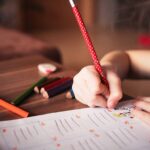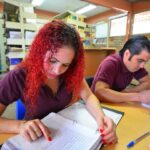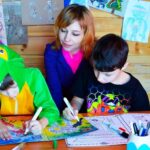Third Grade Language Arts Lessons & Activities by CoreKnowledge
Here is the complete set of freely available Language Arts curriculum Grade 3 materials providing reading and language arts lessons, instructions and teaching modules, published by CoreKnowledge. Included in these content-rich units to help increase student skills are student workbooks, readers, vocabulary cards, flip books and teacher guides. These include learning materials for language arts, history and geography, and science. (All file sizes larger than 5MB are indicated.) Also available by CoreKnowledge are the Kindergarten Reading Lessons and Activities, First Grade Reading Lessons and Activities and Second Grade Reading Lessons & Activities.
Documents to view and download for Grade 3 Language Arts curriculum:
Consonant Flip Book
The Consonant Code Flip Book is used to introduce or review consonant sound-spelling correspondences. It can also be utilized at any time to support individuals or groups in need of targeted remediation and practice.
Vowel Flip Book
The Vowel Code Flip Book is used to introduce or review vowel sound-spelling correspondences. It can also be utilized at any time to support individuals or groups in need of targeted remediation and practice.
Spelling Cards
Spelling Cards are used in conjunction with the Consonant and Vowel Flip Books to record student progress. Teachers affix the spelling to the corresponding chart when a new sound-spelling is introduced.
Wiggle Cards
Each Wiggle Card contains a sentence or phrase comprised of letter-sound correspondences taught in earlier grades. The card directs students to move or act in a certain way. Along with providing decoding practice, Wiggle Cards afford opportunities for kinetic activity.
Assessment and Remediation Guide (15.48MB)
The Assessment and Remediation Guide provides for re-teaching and reinforcement of grade-level objectives that were not mastered in Skill Strand lessons. This online-only resource assists teachers with determining students’ needs, selecting activities and materials that target those needs, adjusting instructional difficulty, and monitoring progress. Use of this resource creates continuity between core classroom and support instruction.
Fluency Packet
The grade 3 Fluency Packet provides opportunities for students to practice reading with fluency and expression. The packet contains poems, folklore, and fables.
Individual Code Chart
Students use the Individual Code Chart to record the sound-spelling correspondences they have learned. They are encouraged to refer to the Individual Code Chart when reading and writing independently.
LA Domain 1: Classic Tales – The Wind in the Willows – Grade 3
Students are introduced to the adventures of Mole, Rat, Badger, and Toad in selections from The Wind in the Willows. Listening to these stories and participating in associated activities reinforces students’ understanding of story elements and exposes them to rich vocabulary, language, and syntax.
- Read-Aloud Anthology: Classic Tales – The Wind in the Willows
- Flip Book: Classic Tales – The Wind in the Willows (20.43MB)
- Image Cards: Classic Tales – The Wind in the Willows
LA Domain 2: Classic Tales – Classification of Animals – Grade 3
Students are introduced to the science of classification. They learn about five groups of vertebrates, why scientists classify animals into groups, and the characteristics of these groupings.
- Read-Aloud Anthology: Classic Tales – Classification of Animals
- Flip Book: Classic Tales – Classification of Animals (21.14MB)
- Image Cards: Classic Tales – Classification of Animals
LA Domain 3: The Human Body Systems and Senses – Grade 3
As part of their study of human body systems, students examine the structure and functions of the skeletal, muscular, and nervous systems. Students also learn about the senses of sight and hearing, and how the eyes and ears work.
- Read-Aloud Anthology: The Human Body Systems and Senses
- Flip Book: The Human Body Systems and Senses (8.25MB)
- Image Cards: The Human Body Systems and Senses
LA Domain 4: The Ancient Roman Civilization – Grade 3
Students are introduced to ancient Roman society and the rise and decline of the Roman Empire. They learn about Roman geography, government, major leaders, monumental battles, myths and legends, social class structure, and forms of entertainment. They also learn about the lasting legacy of ancient Roman civilization in our art, architecture, language, and laws.
- Read-Aloud Anthology: The Ancient Roman Civilization
- Flip Book: The Ancient Roman Civilization (19.88MB)
- Image Cards: The Ancient Roman Civilization
LA Domain 5: Light and Sound – Grade 3
Students learn about the properties of light and sound, how light and sound travel, and how light and sound can be manipulated. They also learn about the life and contributions of Alexander Graham Bell, including his experience with teaching the deaf.
- Read-Aloud Anthology: Light and Sound
- Flip Book: Light and Sound (8.29MB)
- Image Cards: Light and Sound
LA Domain 6 The Viking Age – Grade 3
Students are introduced to the seafaring warriors from Scandinavia known as Vikings. Students also learn about the culture, beliefs, and everyday life of the Norse people.
LA Domain 7: Astronomy – Our Solar System and Beyond – Grade 3
Students learn about the planets in our solar system, as well as celestial objects such as asteroids, meteoroids, and comets. They are also introduced to galaxies, the Big Bang theory, and key people involved in the study and exploration of space.
- Read-Aloud Anthology: Astronomy – Our Solar System and Beyond
- Flip Book: Astronomy – Our Solar System and Beyond (31.41MB)
- Image Cards: Astronomy – Our Solar System and Beyond
LA Domain 8: Native Americans – Regions and Cultures – Grade 3
Students learn about early migrations across a land bridge from from Asia to North America. They learn how early Native American people moved across the Americas and how they adapted to their new environments.
- Read-Aloud Anthology: Native Americans – Regions and Cultures
- Flip Book: Native Americans – Regions and Cultures (11.54MB)
- Image Cards: Native Americans – Regions and Cultures
LA Domain 9: European Exploration of North America – Grade 3
Students learn about the motivations behind European exploration and how those motivations changed over time. They also learn how European explorers and settlers interacted with the Native Americans.
- Read-Aloud Anthology: European Exploration of North America
- Flip Book: European Exploration of North America (9.34MB)
- Image Cards: European Exploration of North America
LA Domain 10: Colonial America – Grade 3
Students learn how the English colonies in North America were established and how each developed a distinctive culture. They also learn how the climate, geography, and motivations of the settlers influenced life in each of the 13 colonies.
- Read-Aloud Anthology: Colonial America
- Flip Book: Colonial America (13.99MB)
- Image Cards: Colonial America
LA Domain 11: Ecology – Grade 3
Students learn about how all living species in an ecosystem are interdependent and interconnected. They also learn about changes to the environment due to natural occurrences as well as the actions of people.
LA Unit 1 Grade 3 Skills – Classic Tales
Unit 1 reinforces many of the skills taught and practiced in the grade 2 Skills program. Students also read a series of literary excerpts in the Student Reader, Classic Tales. In addition, a Beginning-of-the-Year Assessment is administered to each student in order to identify code knowledge gaps.
- Teacher Guide: Grade 3 Skills Unit 1
- Student Workbook: Grade 3 Skills Unit 1
- Student Reader: Grade 3 Skills Unit 1 (7.68MB)
- Supplemental Reader: Grade 3 Skills Unit 1 (9.35MB)
- Supplemental Workbook: Grade 3 Skills Unit 1
- Workbook Answer Key: Grade 3 Skills Unit 1
LA Unit 2 Grade 3 Skills – Rattenborough’s Guide to Animals
Unit 2 introduces the Skills components of spelling, grammar, and morphology. Students also read Rattenborough’s Guide to Animals and learn about warm-blooded and cold-blooded animals, vertebrates and invertebrates, and how scientists classify living things.
- Teacher Guide: Grade 3 Skills Unit 2
- Student Workbook: Grade 3 Skills Unit 2
- Student Reader: Grade 3 Skills Unit 2
- Vocabulary Cards Images: Grade 3 Skills Unit 2
- Vocabulary Cards: Grade 3 Skills Unit 2
LA Unit 3 Grade 3 Skills – How Does Your Body Work?
In Unit 3, students continue to learn and refine skills in spelling, dictionary use, grammar, and morphology. They also learn how to write a paragraph with a topic and concluding sentence. Through their Reader, How Does Your Body Work?, students learn about the skeletal, muscular, and nervous systems of the body.
- Teacher Guide: Grade 3 Skills Unit 3
- Student Workbook: Grade 3 Skills Unit 3
- Student Reader: Grade 3 Skills Unit 3
- Vocabulary Cards Images: Grade 3 Skills Unit 3
- Vocabulary Cards: Grade 3 Skills Unit 3
LA Unit 4 Grade 3 Skills – Stories of Ancient Rome?
In Unit 4, students continue to build skills in spelling, dictionary use, grammar, and morphology. Through their Student Reader, Stories of Ancient Rome, they compare and contrast present-day Rome with the Ancient Roman Empire, learn about the legend of Romulus and Remus, and read several Roman myths.
- Teacher Guide: Grade 3 Skills Unit 4
- Student Workbook: Grade 3 Skills Unit 4
- Student Reader: Grade 3 Skills Unit 4 (9.81MB)
- Vocabulary Cards Images: Grade 3 Skills Unit 4
- Vocabulary Cards: Grade 3 Skills Unit 4
LA Unit 5 Grade 3 Skills – Adventures in Light and Sound
In Unit 5, students learn how to build sentences using adjectives, adverbs, and synonyms. They also practice reading and spelling words with the /ee/ and /ae/ sounds. Through the Student Reader, Adventures in Light and Sound, they are introduced to the concepts of refraction, reflection, pitch, volume, and intensity.
- Teacher Guide: Grade 3 Skills Unit 5
- Student Workbook: Grade 3 Skills Unit 5
- Student Reader: Grade 3 Skills Unit 5
- Vocabulary Cards Images: Grade 3 Skills Unit 5
- Vocabulary Cards: Grade 3 Skills Unit 5
LA Unit 6 Grade 3 Skills – Gods, Giants, and Dwarves
Unit 6 contains a Mid-Year Assessment that evaluates students’ ability to apply grade 3 skills taught thus far. Lessons following this assessment allot time to remediate skills in need of re-teaching as well as provide enrichment opportunities. Through the Student Reader, Gods, Giants, and Dwarves, students learn about Norse mythology.
- Teacher Guide: Grade 3 Skills Unit 6
- Student Workbook: Grade 3 Skills Unit 6 (6.68MB)
- Student Reader: Grade 3 Skills Unit 6
- Vocabulary Cards Images: Grade 3 Skills Unit 6
- Vocabulary Cards: Grade 3 Skills Unit 6
LA Unit 7 Grade 3 Skills – What’s in Our Universe?
In Unit 7, students continue to build skills in spelling, grammar, and morphology. In addition through their Student Reader, What’s in Our Universe, they build a greater understanding of the universe and the celestial bodies within it. At the end of the unit, students apply note-taking skills and their knowledge of the qualities of strong paragraphs to write a research paper on a topic about astronomy.
- Teacher Guide: Grade 3 Skills Unit 7
- Student Workbook: Grade 3 Skills Unit 7
- Student Reader: Grade 3 Skills Unit 7 (5.30MB)
- Vocabulary Cards Images: Grade 3 Skills Unit 7
- Vocabulary Cards: Grade 3 Skills Unit 7
LA Unit 8 Grade 3 Skills – Native American Stories
In Unit 8, students continue to build skills in spelling, grammar, and morphology. The Student Reader, Native American Stories, depicts specific groups of Native Americans living in various regions of North America from an earlier period in time. As students read the text, they consider how people adapt to their environment and how that adaptation can shape their culture.
- Teacher Guide: Grade 3 Skills Unit 8
- Student Workbook: Grade 3 Skills Unit 8
- Student Reader: Grade 3 Skills Unit 8
- Vocabulary Cards Images: Grade 3 Skills Unit 8
- Vocabulary Cards: Grade 3 Skills Unit 8
LA Unit 9 Grade 3 Skills – Native American Stories
In Unit 9, students continue to build skills in spelling, grammar, and morphology. Through their Reader, The Age of Exploration, students learn about navigation, early notions of the location of continents, and journeys to new lands. The explorers studied include Christopher Columbus, Francisco Vasquez de Coronado, John Cabot, Henry Hudson, and Samuel de Champlain.
- Teacher Guide: Grade 3 Skills Unit 9
- Student Workbook: Grade 3 Skills Unit 9
- Student Reader: Grade 3 Skills Unit 9
- Vocabulary Cards Images: Grade 3 Skills Unit 9
- Vocabulary Cards: Grade 3 Skills Unit 9
LA Unit 10 Grade 3 Skills – Living in Colonial America
In Unit 10, students continue to build skills in spelling, grammar, and morphology. Through their Reader, Living in Colonial America, students learn about life in each of the 13 colonies as well as what it was like for people to settle in a new land.
- Teacher Guide: Grade 3 Skills Unit 10
- Student Workbook: Grade 3 Skills Unit 10
- Student Reader: Grade 3 Skills Unit 10 (6.72MB)
- Vocabulary Cards Images: Grade 3 Skills Unit 10
- Vocabulary Cards: Grade 3 Skills Unit 10
LA Unit 11 Grade 3 Skills – Introduction to Ecology
Unit 11’s Student Reader, Introduction to Ecology, familiarizes students with the concepts of food chains, the balance of nature, changes to the environment, and protecting the environment. Students are administered a cumulative End-of-Year assessment, the results of which can be shared with fourth grade teachers via the End-of-Year Assessment Summary sheet included in the Student Workbook.
- Teacher Guide: Grade 3 Skills Unit 11
- Student Workbook: Grade 3 Skills Unit 11
- Student Reader: Grade 3 Skills Unit 11
- Vocabulary Cards Images: Grade 3 Skills Unit 11
- Vocabulary Cards: Grade 3 Skills Unit 11
-love learning -your best ed lessons guide, Scott




